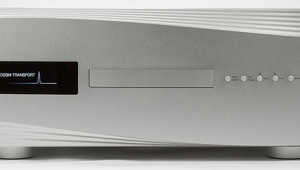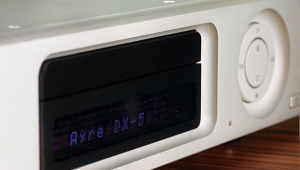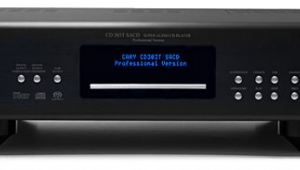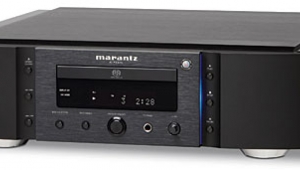| Columns Retired Columns & Blogs |
Esoteric SA-60 universal player Measurements
Sidebar 3: Measurements
I tested the Esoteric SA-60 from its dedicated two-channel L and R output jacks using Sony's provisional Test SACD, as well as CD-Rs and DVD-Rs with the necessary test signals that I'd burned myself. The processing was set to "FIR" for the CD and DVD tests, unless stated otherwise. Tested with the Pierre Verany Test CD, the SA-60 had excellent error correction, if not quite to the standard set by the Marantz and Muse players also reviewed in this issue. It produced an audible glitch at the start of track 34, which has 2mm gaps in its data spiral, but played the rest of the track without problems. However, it muted its output on track 35, which has 2.4mm gaps in the data.
The SA-60's maximum output level at 1kHz was 2.16V from the balanced outputs with both CD and DVD-Audio, 2.14V with SACD. These figures are 0.67dB higher than the CD standard's 2V, but very slightly lower than the specified 2.2V. They were not affected by the signal processing options. The unbalanced output levels were identical, and both sets of outputs were non-inverting; ie, they preserved absolute polarity. (The XLRs are wired with pin 2 hot.) The unbalanced output impedance was a very low 94 ohms at middle and high frequencies, rising inconsequentially to 114 ohms in the low bass. The balanced output impedance, which is usually higher than the unbalanced, was lower, at 80 ohms across the audioband.
Fig.1 shows the Esoteric player's frequency response with all three media. CD gave a perfectly flat result up to 20kHz with both regular and pre-emphasized data, though switching in the RDOT+FIR or DSD processing options both dropped the CD output by 2dB at 18kHz. DVD-A data sampled at 96kHz featured the usual sharp rolloff above 45kHz. However, though the ultrasonic response with SACD data did extend higher in frequency than with 96kHz LPCM data, the rolloff was steeper than usual, the output being down 23dB at 80kHz rather than the typical –12dB at 100kHz. Channel separation (fig.2) was superb, approaching 120dB in the low treble.

Fig.1 Esoteric SA-60, frequency response into 100k ohms (from top to bottom at 40kHz): 96kHz-sampled DVD-A data at –12dBFS, SACD data at –3dBFS. Top traces at 20kHz: pre-emphasized CD data at –12dBFS. Top traces at 20Hz: regular CD data at –12dBFS. (Right channel dashed, 0.5dB/vertical div.)

Fig.2 Esoteric SA-60, channel separation (10dB/vertical div.).
Performing my usual spectral analysis with a swept 1/3-octave bandpass filter while the player decoded CD data representing a dithered 1kHz tone at –90dBFS gave the top pair of traces in fig.3. They peak at exactly –90dBFS, and no harmonic or power-supply spuriae can be seen, other than a suspicious-looking bump at 120Hz in the right channel. In fact, as is increasingly the case, all these traces show is the spectrum of the recorded dither noise on the test CD. Switching to "DSD" with CD playback raised the top-octave noise by 1dB at 10kHz, 6dB at 20kHz, compared to these traces, but this is inconsequential. Playing back dithered 24-bit data from DVD-A significantly lowered the noise floor, the 16dB improvement suggesting that the SA-60's intrinsic resolution was close to 19 bits, which is excellent. Some power-supply components have been unmasked by the lower level of random noise, and can also be seen in the graph of the Esoteric's output while it decided SACD data representing a dithered 1kHz tone at –90dBFS and –120dBFS (fig.4), but these are still very low in absolute terms.
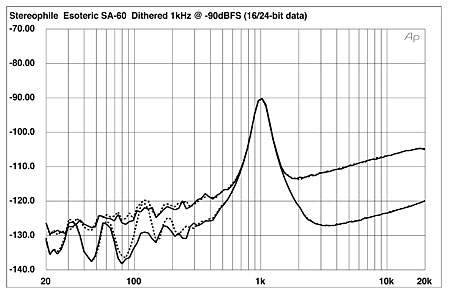
Fig.3 Esoteric SA-60, 1/3-octave spectrum with noise and spuriae of dithered 1kHz tone at –90dBFS (from top to bottom at 3kHz): 16-bit CD data, 24-bit DVD-A data (right channel dashed).

Fig.4 Esoteric SA-60, 1/3-octave spectrum with noise and spuriae of dithered 1kHz tone, SACD data, at (from top to bottom at 1kHz): –90dBFS, –120dBFS (right channel dashed).
The plot of the SA-60's low-level linearity error with CD data was dominated by the recorded dither noise, so I haven't printed the graph. With SACD data, the linearity error was negligible to below –120dBFS, which is excellent performance. With its low noise and excellent resolution, the SA-60 clearly resolved the three DC levels describing an undithered, 16-bit tone at –90.31dBFS (fig.5), while dithered SACD data at the same low level produced an excellent-looking sinewave (fig.6).
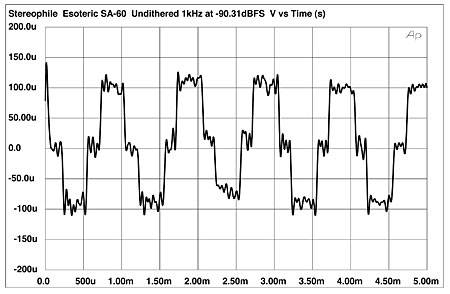
Fig.5 Esoteric SA-60, waveform of undithered 1kHz sinewave at –90.31dBFS, 16-bit data.

Fig.6 Esoteric SA-60, waveform of dithered 1kHz sinewave at –90dBFS, DSD data.
The Esoteric produced low levels of harmonic distortion, even into moderately low impedances (fig.7). (The Esoteric behaved identically on this test with CD data, regardless of the processing selected.) Though the third harmonic is the highest in level, it lies at just –97dB (0.0014%), which is negligible. However, dropping the load to 600 ohms increased the third harmonic to –66dB (0.05%), and the fifth harmonic made an appearance at –90dB (0.003%). I admit that, with the exception of professional audio gear or some strange and wonderful preamps, 600 ohms is a much lower load than the SA-60 will see in real life, but this does suggest that the player not be used with preamps whose input impedance drops much below 5k ohms.
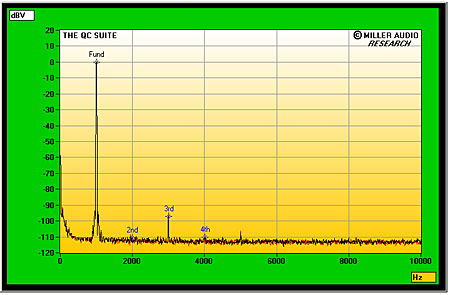
Fig.7 Esoteric SA-60, spectrum of 1kHz sinewave at 0dBFS into 5k ohms (linear frequency scale).
The results of my measuring of the SA-60's high-frequency intermodulation raised my eyebrows. While the intermodulation products were extremely low in level (with the exception of an aliasing product at 24.1kHz), the noise floor around the two high-frequency tones was modulated by the tones (fig.8). Then I remembered that while the Esoteric DV-50 universal player, which Paul Bolin reviewed for Stereophile in August 2003 (Vol.26 No.8), measured conventionally on this test, the Esoteric X-01 player, which John Marks and I wrote about in the February 2005 and May 2005 issues, behaved identically to the SA-60 in this respect. As I wrote then, "Does this matter? On the one hand, such modulation noise can be more audible than its absolute level might suggest. On the other, the...misbehavior appears to affect only the high end of the audioband, and might well be masked both by the musical signal and by the human ear's lack of sensitivity and discrimination in this region. And real music rarely has high levels of the high frequencies that stimulate this behavior."

Fig.8 Esoteric SA-60, HF intermodulation spectrum, CD data "FIR," 19+20kHz at 0dBFS peak into 5k ohms (linear frequency scale).
Switching DSD processing for CD data introduced some changes in this behavior, as can be seen in fig.9. The noise-floor modulation remains evident, but is reduced in amplitude. The reconstruction filter in this mode of operation can be seen to be more "leaky," the aliasing product at 24.1kHz being almost as high in level as the fundamental tones. Some higher-order tones can also be seen in the low treble, though these are still at a very low level in absolute terms.

Fig.9 Esoteric SA-60, HF intermodulation spectrum, CD data "DSD," 19+20kHz at 0dBFS peak into 5k ohms (linear frequency scale).
Finally, when I used the Miller Jitter Analyzer to examine the SA-60's rejection of word-clock jitter, the Esoteric player performed well with all three media. Looking at the spectrum of its output while it decoded CD data (fig.10), the data-related spuriae (red numeric markers) are very low in level, and the only other sidebands visible above the noise floor are ones of unknown origin at ±15.6Hz (purple "1") and ±1470Hz (purple "7"). The actual jitter level was a low 352 picoseconds peak–peak. However, the modulation of the noise floor can also be seen in this graph. A puzzle.
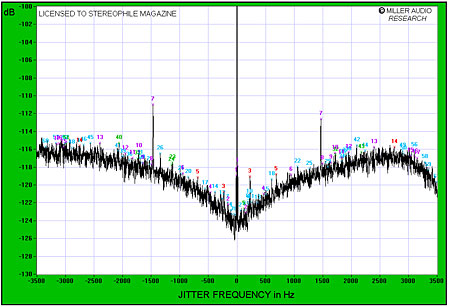
Fig.10 Esoteric SA-60, high-resolution jitter spectrum of analog output signal (11.025kHz at –6dBFS, sampled at 44.1kHz with LSB toggled at 229Hz), 16-bit CD data. Center frequency of trace, 11.025kHz; frequency range, ±3.5kHz.
Other than that behavior, the Esoteric SA-60 offers criticism-free measured performance.—John Atkinson
- Log in or register to post comments

